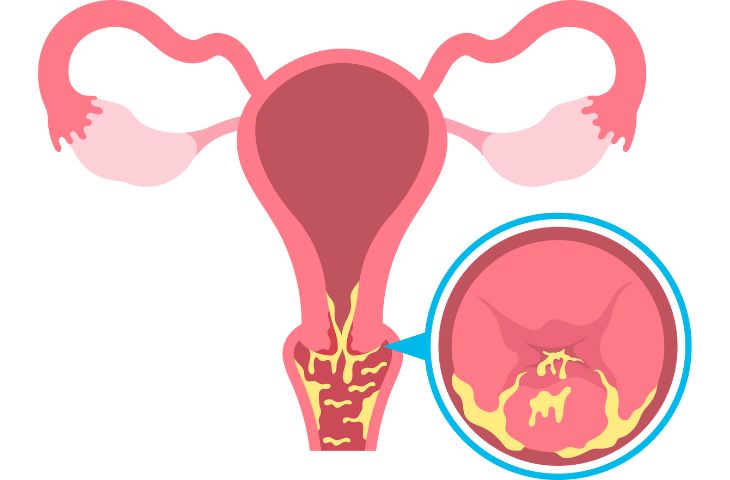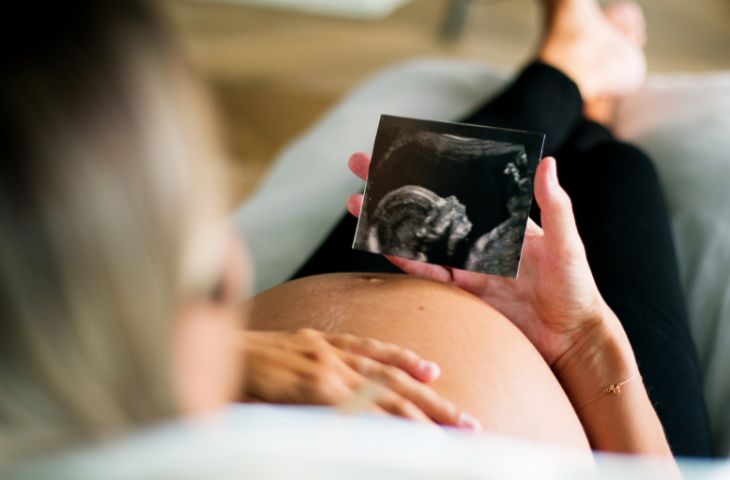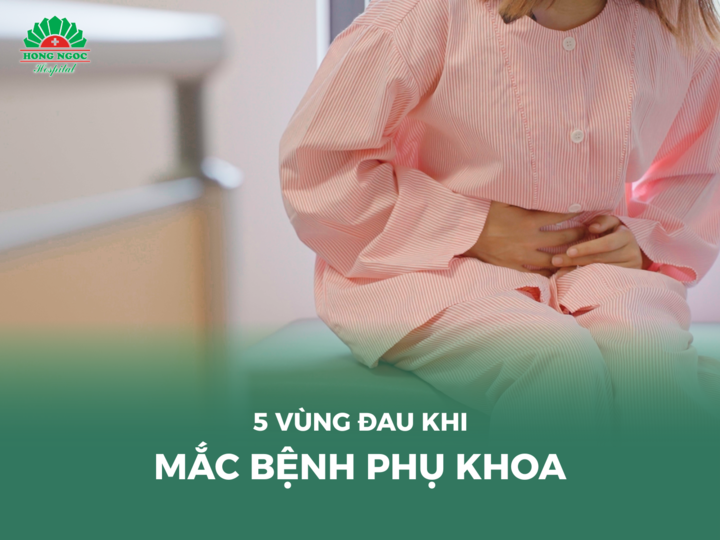Cervical ectropion is a gynecological condition that can cause unpleasant odor in the intimate area, negatively affecting daily life and women’s confidence. If left untreated, it may lead to infertility and, in severe cases, increase the risk of cervical cancer. Concerned about their health, many women ask the question: “How can cervical ectropion be treated?” Hong Ngoc General Hospital recommends four common treatment methods below:
Cervical ectropion
What is cervical ectropion? Cervical ectropion with inflammation refers to infection occurring in the area of the cervix where glandular cells have extended outward (ectropion). Cervical ectropion itself is a benign condition caused by the overgrowth of endocervical glands spreading to the outer surface of the cervix. Because these glands continue to secrete mucus, they create an environment prone to inflammation due to excessive vaginal discharge.
This condition is more commonly seen in women who use oral contraceptives, women who have given birth, and those with congenital cervical ectropion.
What is severe cervical ectropion? Cervical ectropion is classified into three stages depending on the extent of cervical involvement. When the affected area exceeds 70%, it is considered severe cervical ectropion (grade 3).
- Grade 1: the lesion involves less than 30% of the cervix. At this stage, glandular cells have just begun to spread outward. Infections are usually mild and do not significantly affect daily life. Treatment at this stage is relatively simple.
- Grade 2: the lesion involves more than 50% of the cervix. Inflammation is more noticeable and may begin to affect quality of life. Medical examination and treatment are necessary to prevent complications.
- Grade 3: the lesion involves more than 70% of the cervix. This is the most severe stage, associated with a higher risk of complications, and requires prompt treatment.
Causes and symptoms of cervical ectropion

Aside from congenital cervical ectropion, the condition most commonly develops due to daily lifestyle habits. Contributing factors include:
- Improper intimate hygiene: incorrect cleaning methods or frequent vaginal douching without medical guidance can cause infections that spread deeper into the cervix.
- Underlying gynecological conditions: chronic or untreated vaginal infections, cervicitis, and other conditions increase the risk of cervical ectropion.
- Gynecological procedures: intrauterine device (IUD) insertion, abortion, or other invasive procedures may predispose women to cervical ectropion.
Typical symptoms of cervical ectropion include:
- Abnormal vaginal discharge: excessive, often yellowish-green in color, with a foul odor.
- Vaginal itching and burning, with pain during intercourse. In advanced stages, postcoital bleeding may also occur.
- Fatigue and reduced sexual desire.
- Frequent lower abdominal or lower back pain.
When experiencing any of these symptoms, it is important to seek medical evaluation promptly. Do not ignore or underestimate the disease.
For gynecological consultation and examination with highly qualified and experienced obstetricians and gynecologists at Hong Ngoc General Hospital, please contact our hotline at 0916.690.018 or leave your information [HERE].
Complications of cervical ectropion
As mentioned above, cervical ectropion can negatively affect daily life and women’s overall health if not treated promptly.
- Impact on quality of life: abnormal vaginal discharge with foul odor and itching causes discomfort and loss of confidence in daily activities. Many women avoid intimacy due to fear of being judged by their partner.
- Sexual health problems: pain, burning sensation, and bleeding during intercourse reduce sexual desire and may result in diminished sexual satisfaction.
- Spread of infection: prolonged cervical ectropion can lead to infection of other reproductive organs such as the cervix, adnexa (ovaries and fallopian tubes), or fallopian tubes themselves, increasing the risk of pelvic inflammatory disease. This is also a common cause of infertility or subfertility in women of reproductive age.
- Serious complications: long-standing or untreated cervical ectropion may progress to more dangerous conditions, most notably cervical cancer.
Reader may also be interested in:
- Vaginitis: 6 Symptoms, 5 Causes, and 4 Treatment Options
- Uterine fibroids: Symptoms, complications, and treatment options
- Endometriosis: Complications and treatment
Treatment methods for cervical ectropion
There are four main approaches to treating cervical ectropion: medication, cauterization, cryotherapy, and natural remedies.
Method 1: Medical treatment
Medical treatment, also known as pharmacological therapy, is widely used, particularly in cases where the affected area is still small and the infection has not spread to surrounding structures. The commonly prescribed medications include:
- Vaginal suppositories
- Oral antibiotics
- Topical agents for local treatment
Among these, vaginal suppositories are often preferred by physicians because they provide direct, localized action.
Benefits of vaginal suppositories:
- Eliminate bacteria and viruses
- Reduce local inflammation
- Help restore and balance vaginal pH
A typical course of treatment usually lasts 7–10 days. However, it is important to note that medical therapy primarily addresses the symptoms of inflammation rather than completely eliminating the underlying condition.
Method 2: Electrocauterization

There are two main types of cauterization used in treating cervical ectropion: electrocauterization and laser ablation. Among these, laser therapy has gained more attention in recent years due to its positive treatment outcomes.
- Electrocauterization: High-frequency electric current is applied to destroy ectopic glandular cells on the cervix. While this method is commonly used, it can cause discomfort, cervical bleeding, and in some cases, cervical stenosis due to scarring or narrowing of the cervical canal.
- Laser ablation: A laser beam is directly applied to eliminate ectopic glandular tissue and infected cells. This technique generally causes less pain and bleeding compared to electrocauterization. However, if the ablation area is too close to the cervical opening, there is still a risk of scar formation, cervical stenosis, and in severe cases, infertility due to narrowing of the cervix.
Post-treatment note: In the first month following laser ablation, patients often experience increased vaginal discharge. This is a normal sign caused by the regeneration of new epithelial cells, which temporarily increases mucus production. It is essential to keep the genital area clean and dry to prevent reinfection. After approximately six months, vaginal discharge typically returns to normal.
Method 3: Cryotherapy
The cryotherapy method for treating cervical ectropion has the disadvantage of being relatively expensive and not yet widely applied. With this method, doctors freeze the inflamed cells using cold nitrogen gas. The freezing process takes about 30 seconds in order to protect the surrounding tissue and avoid excessive localized freezing, which could make it difficult to conceive.
Prevention of cervical ectropion

According to the Department of Obstetrics and Gynecology at Hong Ngoc General Hospital, cervical ectropion can be prevented by maintaining a healthy lifestyle and proper hygiene practices:
- Maintain intimate hygiene: keep the genital area clean, especially during menstruation and before and after sexual intercourse. Cleanse properly with suitable products, and avoid vaginal douching unless prescribed by a doctor.
- Practice safe sex: always use protective methods. Avoid sexual intercourse during treatment for cervical ectropion. In some cases, the partner or husband may also need examination and treatment if male reproductive disorders are present. Gentle sexual activity is advised to prevent cervical trauma and worsening inflammation.
- Avoid overuse of antibiotics: excessive use may disrupt the balance of beneficial bacteria, worsening the condition.
- Choose appropriate clothing: wear well-fitted underwear made of breathable, absorbent fabric. Avoid tight clothing around the genital area.
- Avoid abortion procedures: to protect reproductive health and reduce the risk of gynecological infections.
Frequently asked questions about cervical ectropion treatment
1. Should cervical ectropion always be treated with cauterization?
Not every case of cervical ectropion requires cauterization. This procedure is usually indicated only when the condition has reached a severe stage and vaginal suppositories or medication have not provided the desired results. The decision to perform cauterization also depends on the woman’s reproductive plans.
Before proceeding, patients undergo a thorough examination so that doctors can accurately assess the extent of the disease and determine whether cauterization is necessary.
2. Can I get pregnant after cervical ectropion treatment?
Yes, pregnancy is possible after treatment, provided that sexual activity resumes only when the body has fully recovered.

Cauterization procedures can cause temporary tissue damage, and the cervix needs sufficient time to heal. Engaging in sexual intercourse before complete recovery increases the risk of recurrence, affects fertility, and in some cases may even lead to infertility. Additionally, scar tissue from cauterization, if not managed properly, may narrow the cervical canal and obstruct sperm from reaching the egg.
Doctors generally recommend abstaining from sexual intercourse for at least one month after treatment to allow complete healing and to protect reproductive health.
3. How long does recovery take after cervical ectropion treatment?
The healing process after treatment typically takes 6 to 8 weeks, which is the minimum time required for the cervical tissue to recover. However, it may take longer before daily life and sexual activity fully return to normal.
For best results, women should seek treatment at reputable medical facilities and strictly follow the physician’s instructions. This not only helps reduce the risk of recurrence but also shortens the recovery period.
Where to treat cervical ectropion effectively?
With more than 20 years of experience in healthcare, Hong Ngoc General Hospital has become a trusted destination for gynecological examination and treatment. Women will receive consultations and personalized treatment plans from highly qualified obstetricians and gynecologists, many of whom have trained and worked at leading national hospitals in Vietnam.
At Hong Ngoc, patient comfort and privacy are top priorities. Women are examined in a private 1-on-1 setting with one doctor and one nurse, ensuring confidentiality throughout the consultation and treatment process. Physicians also provide individualized advice on follow-up schedules and daily lifestyle recommendations to support recovery.
In addition, the hospital is equipped with advanced medical technology and modern diagnostic tools, enabling accurate detection of cervical lesions and supporting doctors in developing the most appropriate treatment for each patient.
Patients will also benefit from Hong Ngoc’s “hospital–hotel” service model, with attentive and professional medical staff, comfortable facilities, and nutritious daily meals designed to promote faster recovery.
Note: The information provided in this article by Hong Ngoc General Hospital is for reference only and should not replace professional medical diagnosis or treatment. For an accurate assessment of your condition, please visit a reputable medical facility for direct consultation with a physician.
Follow the official fanpage of Hong Ngoc General Hospital for more useful health information!













